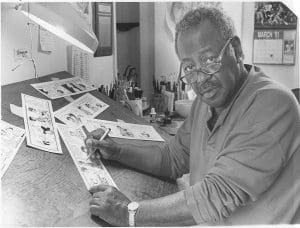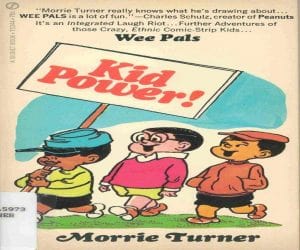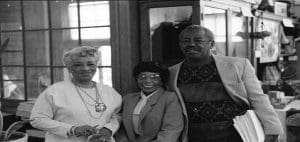For Black History Month AAMLO profiles the late Morrie Turner who broke the comic strip color barrier with his groundbreaking Wee Pals.

By Marco Frazier Library Assistant,
African American Museum and Library at Oakland
This week marks the anniversary of legendary cartoonist Morrie Turner's launch of Wee Pals. The son of a Pullman Porter, Morris Turner, was born in Oakland, California on December 11, 1923. A product of the Oakland school system he attended Cole Elementary and McClymonds High School before completing his studies at Berkeley High School. Turner spent his entire career as the syndicated cartoonist of the WeePals, a multiethnic cartoon strip.
Early Experiment with Drawing
Turner began drawing at the age of 10 as a means of communication. With no TV, and paper from the local butcher shop, he would listen to shows and plays on the radio and draw what he heard. By age 14 he decided he wanted to be a cartoonist. His father was not happy with his desired profession as it was not manly. As his mother would put up her son’s artistic work, his father would take them down. Turner was undeterred by his father’s disapproval. During his childhood, Turner would draw on religious cards he would get from Sunday school class and take crayons and old curtains and reproduce drawings from those cards.

Early Beginnings of Career
An ambitious Turner wanting to get his start in cartooning found himself browsing newsstands seeking magazines that had cartoons in them. He sent his strips to each of these magazines in hopes of getting a response, a process that continued for over a year.
When Turner started cartooning, there was only one other African American cartoonist by the name of E. Simms Campbell. Campbell was an African American cartoonist who drew white characters appealing to white affluent Americans.
The first month of Turner’s career saw him working with an abundance of content and ideas that would race through his head. After the first month, he began to run out of ideas. Nervous about the lack of ideas to use for his comic strip, Turner found himself going through the dictionary finding words and giving them funny definitions. The idea worked. The first comic Turner was paid $5 for a cartoon produced for Baker’s Helper magazine.
Turner’s career began with his comic strip being featured in just 6 newspapers. Things would change with the assassination of Dr. Martin Luther King Jr. After King’s assassination interest in his comic strip increased substantially over time as more newspapers began to pick up his comic strip. Turner was not happy about this success knowing that it was “America’s guilt” that was selling the comic strips. However, as months turned to years, interest in the Wee Pals continued to grow.
Turner’s work both in comics and books reflected stories that focused on issues affecting the African American community including diseases such as AIDS and sickle cell anemia. In his book “Where’s Herbie? A Sickle Cell Anemia Story and Coloring Book”, Turner creates a coloring book with a storyline where children are able to both interact and learn at the same time.
Wee Pals

Morrie Turner’s comics reflected the social commentary and events of the day. On February 15, 1965, at the height of the Civil Rights movement, Turner created the WeePals. Wee Pals became a syndicated comic strip in newspapers across the country and featured a multiethnic cast of characters that represent different cultures. He considered his cartoon to be the “Black Peanuts”, an offshoot of legendary Peanuts creator Charles Schultz.
As a part of the comic community, Turner was an advocate who led the push for other cartoonists to integrate their strips. When African Americans were portrayed in comic strips many portrayed them as black-faced characters with big white lips. Turner wanted to change this stereotype. During a gathering of California cartoonists, Turner met legendary Peanuts legend Charles Schulz. He asked Schulz why he didn’t have black kids in his comic strip. In conversation, Schulz encouraged Morrie to create an integrated script. Turner began a campaign to end the all-white character comic strips. While campaigning for change in the comic industry, he recognized that his comic strips were all Black. Turner decided that he had to be the first to integrate his own strip.
Soul Corner
One year during “Negro History Month,” Turner added Soul Corner to accompany his weekly comic strip. After such a positive response, he decided to continue the tradition. Soul Corner would feature an individual who made contributions to the African American community when they were alive. Soul Corner always featured deceased individuals as his strips were produced 13 weeks in advance. By the time the strip made it to print a lot could have happened in a person’s profile.

As the Civil Rights movement was nearing its end, Turner turned his focus to tolerance. He created Rainbow Power depicting a diverse group of people of different ethnicities that not only got along with one another but worked together. Rainbow Power depicted nationalities and themes such as green power representing money, black power representing African Americans, grey power representing the elderly, red power representing Native Americans, brown power representing Latinos, yellow power representing Asians, and then there was Ralph the Caucasian character. All of the characters would get together with Nipper the main character portrayed by Morrie.

Morrie Turner was not only a comic but was one of the founders of the East Bay Negro Historical Society; the group responsible for what is now the African American Museum and Library at Oakland. Morrie Turner died on January 24, 2014, but his legacy lives on in the Archives collection here at the African American Museum and Library at Oakland.
For more information on cartoonist Morrie Turner including interviews, photographs, and more view:
The interview of Morrie Turner on Calisphere at:
https://archive.org/details/caolaam_000020
The collection of Morrie Turner on the Online Archive of California at:


Add a comment to: Celebrating the Life of Morrie Turner on the Anniversary of Wee Pals